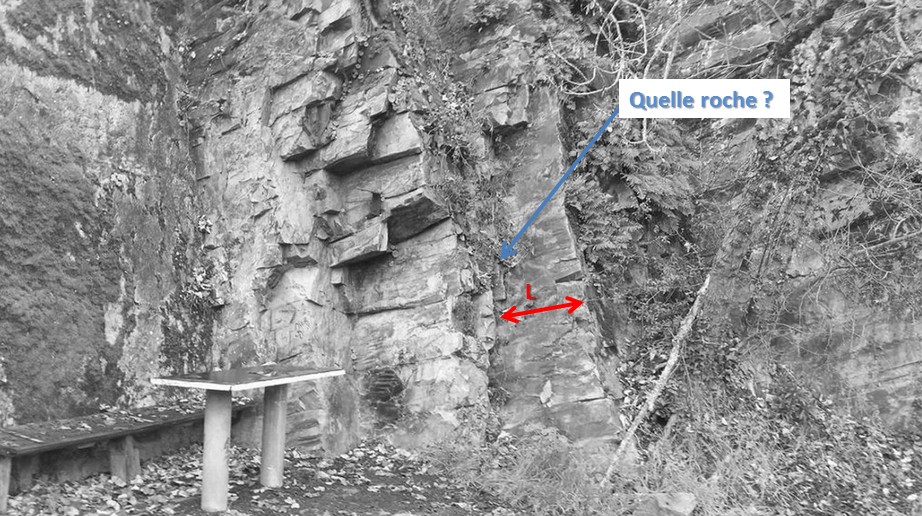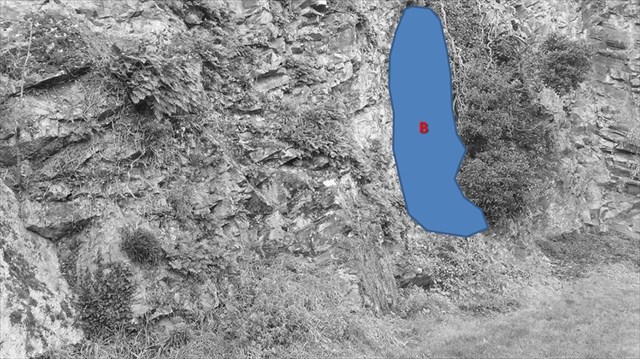La Earthcache / The Earthcache
Le plan d'eau du Gotha et la petite zone de loisirs adjacente ont été aménagés au cœur d'une ancienne carrière qui exploitait une roche claire, dure et compacte qui forme un petit relief sur lequel est implanté l'église de Saint-Géréon.

Mais quelle roche était donc exploitée dans cette carrière ? Nous allons essayer d'en savoir plus.
► La roche du Gotha d'après le BRGM
Quand on étudie la carte géologique du BRGM, voici ce qu'elle nous dit de la zone qu'occupe actuellement l'ancienne carrière du Gotha

Nous serions donc en présence d'une couche de "|X7. Microgranites liés au Granite de Mésanger."
D'après le BRGM, il s'agirait d'une roche d'un beige clair, peu grenue, très diaclasée, à mésostase très riche en séricite, appartenant au type aphanitique.
On qualifie d'aphanitique une roche magmatique qui ne montrent pas - mis à part quelques individus isolés - de cristaux discernables à l'œil nu.
Les microgranites sont donc de manière générale des roches ignées acides avec la même composition minérale que les granites, mais avec des cristaux beaucoup plus petits.

Le microgranite a ainsi une position intermédiaire entre le granite (roche plutonique à structure grenue) et la rhyolite (roche volcanique à structure microlithique - grain invisible à l'oeil nu).
Et justement une autre hypothèse, émise par E.Bureau, consiste à dire qu'il s'agirait en fait d'une ancienne carrière de rhyolite prismée.
► La roche du Gotha d'après E.Bureau
Vu également comme une roche très largement aphanitique, la roche du Gotha est cette fois considérée par E.Bureau comme une rhyolite dont l'architecture est remarquable.
La rhyolite est une roche magmatique volcanique de couleur assez claire : rosée ou grise et parfois bleue. C'est une roche à structure microlitique présentant des minéraux visibles à l'œil nu : quartz, feldspaths et amphibole.
La rhyolite est l'équivalent volcanique du granite.

Dans l'ancienne carrière du Gotha, un examen approfondi du front de taille montre que les nombreuses "diaclases" qui découpent la roche correspondent en fait à la prismation du corps magmatique lors de son refroidissement à proximité de la surface du sol.
Les primes sont disposés symétriquement de part et d'autre d'un corps central prismé horizontalement.
L'âge de formation de cet ensemble rhyolitique serait au Carbonifère, soit autour de 320-325 Ma.
Du point de vue pétrologique et géochimique, il se révèle proche des cinérites connues sous le nom de "Pierre Carrée" dont il pourrait être la source d'alimentation.
The water of the Gotha and the small adjacent recreation area have been built in the heart of a former quarry that operated a clear rock, hard and compact which forms a small relief which is located the church of Saint Gereon.

But what rock is exploited in this career? We will try to learn more.
► Rock of Gotha by BRGM
When studying the geological map of BRGM, this is what it tells us of the area currently occupied the old quarry of Gotha :

We would therefore be in the presence of a layer of "|.. X7 microgranites related to Granite of Mésanger".
According BRGM, it would be a rock of a light beige, slightly grainy, jointed , very richin mesostasis sericite, and belonging to aphanitic kind.
It qualifies as aphanitic an igneous rock that does not show - apart from a few isolated individuals - discernible crystals to the naked eye.
The microgranites are therefore generally of acid igneous rocks with the same mineral composition as granite but with much smaller crystals.

The microgranite has an intermediate position between granite (plutonic rock with grainy structure) and rhyolite (volcanic rock Microlithic structure - grain invisible to the naked eye).
And another hypothesis exists, issued by E.Bureau is to say that it would in fact an old prism-ballasted rhyolite quarry.
► Rock of Gotha according E.Bureau
Also seen as a largely aphanitic rock, the rock of the Gotha this time is considered by E.Bureau as a rhyolite whose architecture is remarkable.
Rhyolite is a volcanic igneous rock pretty light color: pink or gray, sometimes blue. It's a rock microlitic structure with invisible minerals to the naked eye: quartz, feldspar and hornblende.
Rhyolite is the volcanic equivalent of granite.

In the old quarry of Gotha, a thorough review of the working face shows that many "joints" that cut the rock in fact correspond to the prismation magmatic body during cooling near the surface.
Premiums are disposed symmetrically on either side of a central body prism horizontally.
The age of formation of this set would rhyolitic Carboniferous at around 320-325 Ma.
The petrological and geochemical point of view, it appears near cinerites known as the "Pierre Carree" of which it could be the power source.
► Sources bibliographiques / Bibliographical sources
Les Questions / The Questions
La lecture attentive du descriptif de la cache, ainsi qu'une observation des éléments de terrain et un peu de déduction sont normalement suffisants pour répondre aux questions de cette EarthCache.
A careful reading of the description of the cache, as well as observation of terrain features and some deduction is usually sufficient to answer questions of this EarthCache.
Questions pour valider :"Mais quelle roche au Gotha ?"
Questions to validate: "But what a rock in Gotha?"
Point 1 : N 47° 22.107 W 001° 11.862
Vous pouvez voir un affleurement derrière la table de picnic (photo WP1). Étudions le de plus près.
You can see an outcrop behind the picnic table (photo WP1). Study it more closely.

- Question 1 : Décrivez la roche que vous voyez (couleur, texture). A votre avis, de quelle roche s'agit-il ?
- Question 1 : Describe the rock you see (color, texture). In your opinion, what is it rock?
- Question 2 : Mesurer la largeur L du pan de roche (flèche rouge)
- Question 2 : Measure the width L of the rock face (red arrow)
Point 2 : N 47° 22.115 W 001° 11.864

- Question 3 : Décriver la forme que prend la roche sous la zone bleue B (photo WP2).
- Question 3 : Describe the form in which the rock under the blue area B (photo WP2).
- Question 4 : en fonction des questions et observations précédentes, quelle est l'hypothèse la plus vraisemblable, celle du BRGM ou celle de E.Bureau ?
- Question 4 : Depending on the issues and previous observations, what is the most likely scenario, where the BRGM or that of E.Bureau?
Vous pouvez vous loguer sans attendre notre confirmation,
mais vous devez nous envoyer les réponses en même temps soit par mail via notre profil (
fafahakkai), soit via la messagerie geocaching.com (Message Center).
S'il y a des problèmes avec vos réponses nous vous en ferons part.
Les logs enregistrés sans réponses seront supprimés.Une photo de vous ou de votre GPS en Noir&Blanc avec le plan d'eau en arrière plan serait la bienvenue, mais n'est pas obligatoire.
You can log this cache without waiting for our confirmation, but you must send us the answers at the same time, by e-mail via our profile (fafahakkai) or by the system of Message Center of geocaching.com.
If there is a problem with your answers we will notify you. The logs recorded without answers will be deleted.
A Black&White picture of you or your GPS with the water in the background, is welcome, but not mandatory.
Rappel concernant les « Earthcaches »: Il n'y a pas de conteneur à rechercher ni de logbook à renseigner. Il suffit de se rendre sur les lieux, de répondre aux questions ci-dessus et de nous renvoyer les réponses.
Reminder concerning "Earthcaches": there is neither a container to look for nor a logbook to sign. One need only go to the location, answer to the differents questions and send us the answers.